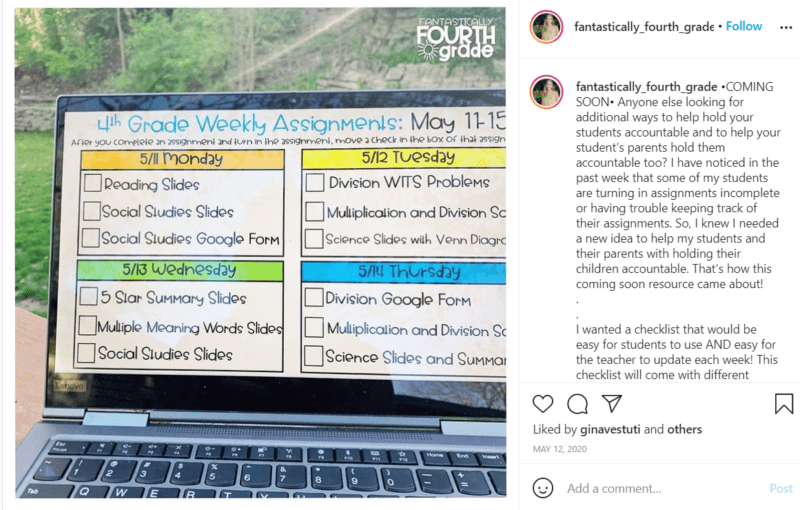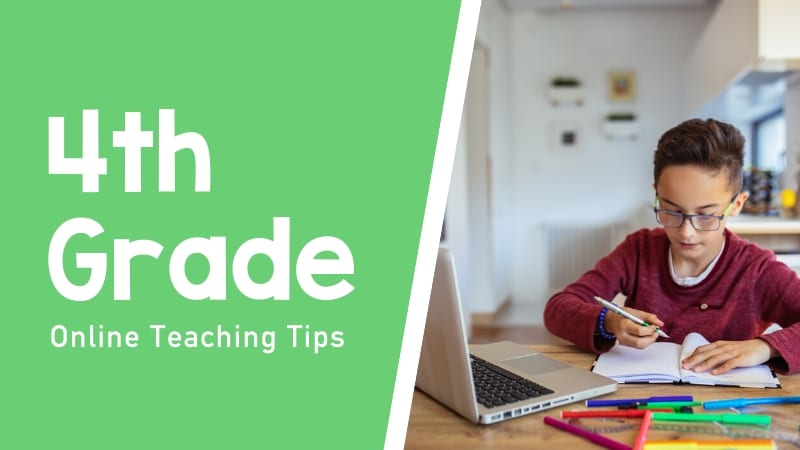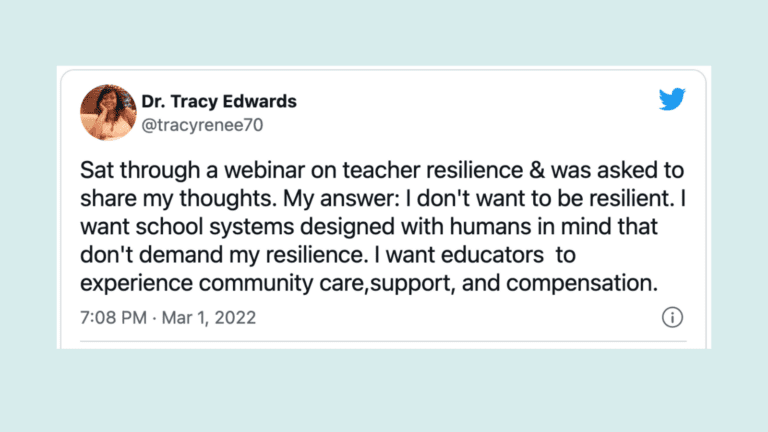Any 4th grade teacher will tell you that 4th grade is a pivotal year for kids. The students have amazing energy, increased anxiety level, and are able to take on a higher level of academics. Online learning makes these changes even harder for your 4th grade students. If you’ve looked around to consider what resources might help, you’re probably pretty overwhelmed. We hear you, so we curated practical 4th grade online teaching tips from teachers who are doing their best to be there for students:
Get Ready and Prepared
1. Be there for yourself so you can be present for them
Just like in the classroom, students learn best when their teacher is calm and present, so start by taking care of yourself so you can care for your students. Begin by setting up a small space with some of your favorite teaching tools and objects. Designate an area you will consistently use when you are teaching. You need to feel this space is your classroom, and that when you arrive, it is class time. Just like starting your morning with a cup of coffee or writing out the day’s schedule on the whiteboard when you arrive at school, a designated online teaching space will help you mentally transition from your “home” mindset to “teaching” mindset.
2. Know thy 4th grader
Let’s discuss the typical fourth grader. Whether they feel joy or anxiety, emotional intensity is a defining trait of fourth graders. It can feel like most of their sentences end with an exclamation point, as in “Yes! We have art class today!” or “Not fair! I thought you said we’d do more read aloud today!” Nine and ten-year-olds care deeply about what’s going on at school and are rarely ambivalent. They are talkative, active, industrious and curious, but can also be quite competitive, intense, and self-critical.
Physically, they are developing quickly. When playing outside, they often push themselves to physical limits and tend to be more tired and hungry as a result.
Fourth graders enjoy wordplay, new vocabulary, and descriptive language. They begin to see the world more broadly—including social issues—and can draw information from printed materials. Fourth graders are still more literal and prefer concrete learning. Stay on guard for signs of overwhelm and overly self-critical behavior. Keep things light and tap into the humor and playfulness of this age group throughout the day.
[contextly_auto_sidebar]
3. Join a 4th grade teacher Facebook group
You don’t have to navigate online learning alone! While every home and school combination situation is different, it’s good practice to connect with others who are in similar circumstances. Without the teachers’ lounge as a place to exchange ideas and strategies, online groups can be a good way to build a community of support. If you’ve sworn off social media, now might be a good time to consider a thoughtful reentry just to feel less alone and to find your teaching people. Here are some fourth grade focused Facebook groups you might want to check out:
- Fabulous Fourth Grade Teachers
- Not So Wimpy 4th Grade Teachers
- Fourth and Fifth Grade Chalk Talk
- Upper Elementary Educators
- Fourth Grade Teacher Chat
Set Up Your Online Classroom
4. Keep an online classroom where everything is organized
Now that you’re ready with your physical space and mental clarity, it’s time to build your online classroom. Your online classroom should have all the same essential elements as your physical classroom including an assignment board, library, assignment inbox, and student communication tools. Your district or school may have chosen the platform for you, in which case, stick with it. Parents and kids need to hear a consistent message, so doing it differently might cause confusion.
Middle schools tend to use Learning Management Systems (LMS) more regularly than elementary schools. So, if your fourth grade hasn’t been using an LMS from the start, you’ll need to set it up and consider the best ways to teach how to use it. Many teachers have found that beginning with low-stakes, fun tasks to complete using the LMS is a great way to help students get used to the system.
Source: Diary of a Not So Wimpy Teacher
5. Choose an online video conferencing program, if you are able
Your students like to see you! Online video conferencing allows you to have face-to-face time with your students. While many schools or school districts choose a video conferencing tool for teachers, for those who can select their own platform, Google Meet and Zoom are popular choices. Some teachers aren’t being allowed to do video conferencing with students. Along these same lines, some video chats are optional and some are required. Follow your school’s guidelines as appropriate.
6. Try a threaded discussion chat
If you are unable to do video chats or don’t want to do them every day, try a threaded discussion chat. Kids still need a predictable structure for how to connect and ask questions. Try discussion boards like Google Classroom, Blackboard, and Canvas. Another one of our favorite discussion board apps is Padlet.
7. Have set office hours for kids to reach out to you
Fourth graders may feel awkward contacting you digitally to ask questions. The simpler and easier you can make it may make a big difference. Having regular office hours also helps students feel that you are there for them even when learning online.
Manage Your Classroom
8. Engage 4th graders online based on their development
You’ve got the platforms and systems in place. Now it’s time to actually manage the classroom online. Here are a few quick initial tips:
- Put them in small online and buddy groups where they can check in with their peers.
- Give them short learning spurts and time to process and share their thoughts.
- Tap into their natural passion for fairness by including discussions of right and wrong, justice, and fairness in science and social studies lessons.
- Assign them online games that use wordplay to complete.
- Provide regular opportunities for movement, silliness, and self-expression
9. Use your previous lesson plans and pacing guide, but prepare to adapt
For both students and teachers, there’s a lot to learn about how online learning works. It may take additional time and effort to help students master online tools, which can make the whole process feel like it’s taking forever. That’s okay. Re-evaluate your lesson plans to include time for students to log in, open documents, start video calls, and complete other technology setup tasks.
Fourth graders tend to be more self-critical and anxious than other grades, so online learning should be chunked into smaller pieces. They need to feel successful after each chunk, so they will want to move forward with the next.
Your pacing guides were developed with in-person classrooms in mind. It’s awesome if you make it all the way through, but you may also need to slow down and share the information in different ways if it seems like students are struggling. Provide ample encouragement and remind students that they’re growing new skills each day as they adapt to online learning.
10. Be consistent about your routines
Building predictable, consistent systems in your online classroom will help you keep your sanity and help your fourth graders adapt to online learning routines. Start slowly. The best way to start is to keep one simple document with hyperlinks that students can reference and click on to get to the different things they need each day. After you’ve set up standards for where to find things and what’s expected, you can transition to assigning and collecting student work through the LMS. Also, set up your video or threaded message chats there. Weekly checklists are a great way to keep students accountable for assignments while also making it easy for parents to know what to expect.

Source: @fantastically_fourth_grade
11. Encourage independence
The independent skills your fourth graders learn now will help them down the road. Kids are learning how to be organized, how online learning works, and how to maintain social relationships through technology. Provide encouragement and take time to acknowledge the progress you see them making.
12. Let 4th graders do their favorite thing—talk
Fourth graders are very talkative—if they think it, they say it. The mute button can tame those verbal reactions (Wow! Cool! Ewww!) commonly blurted out during read-alouds and lessons, but quashing all forms of spontaneous reaction and verbal engagement may leave students feeling disconnected. Give students the opportunity to connect with each other through intentional chat breaks and pair projects. Not only will they appreciate it, but it may be the sole reason they sign on during synchronous two-way video meetings.
13. Prioritize student communication & collaboration
Learning remotely is such a new experience for students who are used to seeing their classmates every day. If you prioritize student communication, collaboration, and interaction, the quick feedback will reap the benefit of more connected fourth graders. They are used to getting their answers from you quickly so they can keep going. That isn’t going to change.
14. Manage online classroom behaviors
Some of the behaviors you see in your classroom will be similar to the behaviors you’ll see online. Keep online learning safe, predictable, and positive for students by making your expectations very clear. Be selective (not random) about grouping. Put kids who tend to work well together, so you know which groups need more support. Fourth graders need boundaries and consistent boundary reinforcement. Explain behavior consequences for rudeness, inappropriate behavior, and distractions. This free PBIS guide to remote learning behavior can help you put your plan into action.
Add To Your Classroom
15. Create your own videos when the topic is more difficult
Many teachers have had success in creating short videos about key concepts. These videos can be uploaded to the LMS and assignments added under each video. Students can watch the videos when they can and review them as needed while working on assignments. This is a great way to help kids see that you are still around and available.
16. Use these online tools that work particularly well with 4th graders
- EdPuzzle: Great for engagement and helping 4th graders with metacognition
- Biblionasium: Students can track what they’ve read, write reviews, and discover new books.
- Kahoot: This a prime age for games that let everyone participate synchronously.
- Flipgrid: Empower every voice in your class through short video responses.
- Make Beliefs Comix: Many 4th graders process and share their knowledge better with images.
17. Try some games suited to 4th grader sensibilities
Fourth graders love games that speak to their playful, talkative side and allow them to connect with others. A scavenger hunt can be a great place to start. This could mean simply asking students to bring something yellow to share at the morning meeting. Note: not every student comes to the online discussions willing to play a game. Some kids may stop attending video chats if they are only used for connecting socially. You might want to let kids know that games or activities for connecting with each other run for the first 5-10 minutes, and they can join after if they so choose. Giving kids this choice helps them manage their expectations.
18. Explore these 4th grade resources to add depth to your lessons
Feeling overwhelmed with resources? Then leave these for later or choose just one to explore. When you’re ready, you’ll find everything you need to keep your lively, curious, funny fourth graders engaged and learning online.
- Awesome Websites, Games, and Learning Activities for Fourth Graders
- 50 of the Best Books for 4th Grade
- 17 Great Learning Podcasts for the Classroom
- 4th Grade Online Games
- Khan Academy’s Fourth Grade Math
- Fourth Grade Math, Language Arts, and Science Videos
- 21 Fantastic and Free Fourth Grade Math Games
- 30 Impressive 4th Grade Science Experiments and Activities
What are your favorite 4th grade online teaching tips? Please share in the comments!
Plus, don’t forget to sign up for our weekly emails to receive more ideas!
Looking for more ways to connect to your fourth graders? Check out 350+ Amazing Online Learning Resources !


